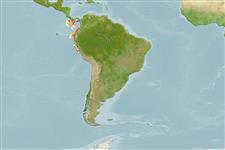>
Gadiformes (Cods) >
Macrouridae (Grenadiers or rattails)
Etymology: Nezumia: A Japanese word that means "mouse".
More on author: Garman.
Environment: milieu / climate zone / depth range / distribution range
Écologie
marin bathydémersal; non migrateur; profondeur 589 - 1400 m (Ref. 1371). Deep-water; 8°N - 12°S, 86°W - 78°W (Ref. 1371)
Eastern Pacific: Panama to northern Peru.
Taille / Poids / Âge
Maturity: Lm ? range ? - ? cm
Max length : 23.0 cm TL mâle / non sexé; (Ref. 1371)
Description synthétique
Clés d'identification | Morphologie | Morphométrie
Épines dorsales (Total) : 2; Épines anales: 0. Snout short, conical, with a small but stout, distinctly bifid scute at its tip. Chin barbel very short. Underside of the snout and part of the suborbital space without scales; mandibular rami with loose scales along midline of each ramus; pores of the lateralis system indistinct on the head, although a small dark papillae is prominent. Pyloric caeca 17 to 25. Body scales are fairly large and deciduous, with lanceolate spinules arranged in convergent rows. Overall color is swarthy to brownish, the abdominal region bluish black; mouth dusky, gill cavity black except for pale areas ventrally and along medial wall; fins dark brown to brownish black.
Found on the continental slope (Ref. 9315). Feeds mainly on copepods and small benthic invertebrates (Ref. 9315). Minimum depth from Ref. 58018.
Life cycle and mating behavior
Maturité | Reproduction | Frai | Œufs | Fécondité | Larves
Cohen, D.M., T. Inada, T. Iwamoto and N. Scialabba, 1990. FAO species catalogue. Vol. 10. Gadiform fishes of the world (Order Gadiformes). An annotated and illustrated catalogue of cods, hakes, grenadiers and other gadiform fishes known to date. FAO Fish. Synop. 125(10). Rome: FAO. 442 p. (Ref. 1371)
Statut dans la liste rouge de l'IUCN (Ref. 130435: Version 2024-1)
Menace pour l'homme
Harmless
Utilisations par l'homme
Pêcheries: pêcheries vivrières
Outils
Articles particuliers
Télécharger en XML
Sources Internet
Estimates based on models
Preferred temperature (Ref.
123201): 5.1 - 6.5, mean 5.5 °C (based on 6 cells).
Phylogenetic diversity index (Ref.
82804): PD
50 = 0.5000 [Uniqueness, from 0.5 = low to 2.0 = high].
Bayesian length-weight: a=0.00214 (0.00109 - 0.00421), b=3.20 (3.03 - 3.37), in cm total length, based on LWR estimates for this (Sub)family-body shape (Ref.
93245).
Niveau trophique (Ref.
69278): 3.3 ±0.25 se; based on food items.
Résilience (Ref.
120179): Milieu, temps minimum de doublement de population : 1,4 à 4,4 années (Preliminary K or Fecundity.).
Fishing Vulnerability (Ref.
59153): Low vulnerability (13 of 100).
